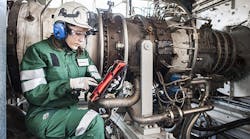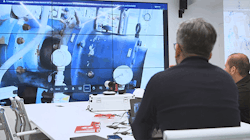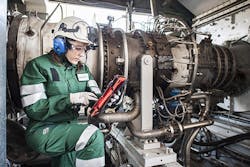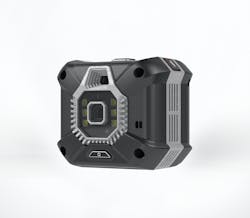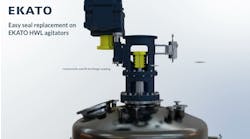The acceptance of wearable technologies of many different stripes was increasing before COVID-19. However, the pandemic has underscored the value of lightweight, safe and cost-effective wearable devices and boosted their use by chemical makers to improve operational efficiency, speed equipment testing and improve worker safety.
Total, Paris, has used wearable technology from RealWear, Huntsville, Ala., for nearly three years now. The U.S. company’s flagship product, the HMT-1 headset, is a ruggedized Android-class tablet computer that frees workers’ hands for difficult or dangerous jobs. The headset simply clips onto hard hats.
Total’s first application of RealWear’s headsets came in 2018 at its Grandpuits refinery in Seine-et-Marne, France, followed closely by a second at its Lyndsey refinery in Immingham, U.K. (Total agreed this summer to sell that refinery to the U.K.’s Prax Group.)
Software posed one of the major hurdles with these early applications because the subject matter experts (SMEs) based in France and the front-line workers used different operating systems. The addition in 2020 of Microsoft Teams overcame this obstacle as both sides of the technology “border” were familiar with its use.
In July 2020, Total announced the world’s first commercial deployment in the chemical industry of Microsoft Teams on RealWear at its polypropylene plant in La Porte, Texas. Clipped onto a hard hat, the device runs voice-enabled Microsoft Teams and enables plant workers to use both hands for complex work procedures while remotely communicating in real time with SMEs wherever they are in the world.
“There has been widespread adoption of Teams by Total employees prior to Covid-19. This made the combination of the RealWear connected helmet and Teams easy and fast as everyone involved was already familiar with the application. Once the device had its own Microsoft generic account, it could be added to any Teams call or meeting just as if it were another employee,” explains Nabil Lamia, senior process engineer and digital leader, refining and chemicals, for Total.
“Not only is the communication audible and visual from the field but the same content you might normally expect in a Teams meeting screen share can now also be seen by the wearer in the field. This applies to things like drawings, diagrams, procedures, process trends, etc.,” he adds.
Figure 1. Experts based at refinery in France remotely guided inspection of equipment at Texas plant. Source: Total.
For example, Lamia cites the handling of an intermittent thrust bearing vibration issue reported by the night operations staff at LaPorte. Lamia and other SMEs in Total’s “smart room” (Figure 1) at its 12-million-mt/y refining and petrochemicals complex at Gonfreville, France, guided the superintendent of maintenance at LaPorte in checking the suspect equipment. Following the investigation, Total’s SME in charge of machinery development allowed the unit to continue operating with ongoing monitoring.
Since then, the company has used the connected helmet in many other applications. For example, company engineers and a wastewater treatment specialist who was working from a home office in Lyon, France, due to strict pandemic lockdown conditions simultaneously supervised repairs executed on the scraper bridge of the oil skimmer at the Grandpuits refinery, easing checking and approval.
Similarly, the connected helmet was used while inspecting the outer screen in the continuous catalytic reformer regenerator at Total’s refinery in Port Arthur, Texas. Reformer network and UOP specialists witnessed the inspection and interacted in real time with the process engineer in the regenerator through Teams.
The high quality pictures allowed remote specialists easily to notice in livestream that the chlorination section was slightly fouled by catalyst fines which wasn’t the case in the burn section above.
To date, Total has installed 55 RealWear devices worldwide and is adding more.
“The idea is to have at least one pair of devices per site in our upstream, midstream and downstream activities. We strongly believe that this digital tool will be a must-have tool even post-Covid,” says Lamia.
The appetite for wearable technology is particularly strong among process and electrical/instrumentation engineers, together with operations and maintenance technicians, he notes.
The latest move from Total is the launch of a concept study with one of its digital partners for integrating tailor-made augmented reality on RealWear devices to assist outside operators during critical procedures.
“The goal is to create a virtual ‘technical angel’ that will show the operator step-by-step procedures to be executed, including cross-checking with the operator in the control room and/or remote support of a SME. A proof of concept is ongoing in one of Total’s refining and chemical sites,” he concludes.
Figure 2. Engineer in Italy uses helmet to share data with people around the world during equipment test. Source: Baker Hughes.
Virtual String Tests
Meanwhile in November, Venture Global LNG, Arlington, Va., announced the arrival of the first two liquefaction trains at its Calcasieu Pass LNG export facility in Cameron Parish, La. Now being connected to their respective cold boxes, the two 0.6-mt/y trains and mixed refrigerant compressor skids arrived less than 15 months after the project’s final investment decision — which the company is hailing as both a major project milestone and a step change in LNG construction.
The trains came from Baker Hughes’ manufacturing facility in Avenza, Italy, more than two months ahead of the contractual delivery date. This only could have been achieved, say the companies, by their use of novel virtual string tests carried out by Baker Hughes engineers in Italy using wearable technologies.
A string test is a major project milestone performed on the first full set of equipment. Replicating and simulating site operation conditions for the complete system, is the only way to prove that all the major components function together as they should.
Every component destined for the final project site is commissioned and validated to verify functionality. Putting the components together for the test enables identifying — and resolving — any fit or assembly problems. The test performs a mechanical running assessment as well as measures equipment vibration and bearing temperatures at full speed and full load. The auxiliary and control systems also are calibrated, which minimizes these activities in the field.
Baker Hughes field service engineers used a Smart Helmet — an industrial wearable that combines a hard hat with various cameras, computer vision and sensors — to let everyone participate in a walkdown of the string test equipment in Italy (Figure 2). It enabled real-time communication so Venture Global’s engineers could view specific parts of the equipment package.
Baker Hughes addressed technical questions right after the test; Venture Global signed the String Test Acceptance Certificate the same day, which is rare.
Baker Hughes introduced remote string tests several years ago but Venture Global was the first to adopt the fully remote approach. In addition to its standard service offerings already available remotely, such as monitoring and diagnostics, Baker Hughes has extended the use of remote technology to outage preparation for customers as well as virtual training, inspection and repairs on critical rotating equipment in operation in the field.
“Any personnel conducting an activity like a string test or factory acceptance test (FAT) can utilize wearable technology to allow remote or virtual monitoring. For some of the FAT protocols, wearable technology applications require more pilot testing to overcome existing requirements for a live witness. In terms of future applications, we are continually working with our customers to determine opportunities where wearable technology can further enhance remote collaboration and onsite safety,” notes a spokeswoman.
Worker Safety
Guardhat, Detroit, specializes in developing wearables, infrastructure and software platforms to provide a safer and more productive work environment for workers in heavy manufacturing industries.
Its own connected-worker software platform collects and analyzes real-time data gathered by wearables such as the HF1 and HC1 smart hard hats, and the TA1 tag, which provides location tracking, audio-visual (AV) telecommunications, workers’ safety features such as alerts for emergency help, proximity detection and AV media collection features. The company’s Rhea Android app complements these wearables; it provides location tracking and core safety features plus a mobile version of Guardhat’s own safety control center.
The chemical industry uses the technology in a diverse range of applications including personal protective equipment (PPE) compliance, checking the condition and vitals of workers, hazard and environment monitoring, man/machine interactions and ensuring lone worker safety. Turnaround management also is a major application.
In one example cited by Indranil Roychoudhury, Guardhat’s chief operating officer, deployment of its hardhats, tags and connected-worker software platform increases worker safety and productivity at a plant with a nitrogen silo area operated by a global chemical company.
“In this zone, the oxygen level can dip to alarming levels and cause injury as well as fatalities. The workers are required to wear oxygen masks to monitor their oxygen levels. Very frequently workers did not comply with the oxygen mask PPE requirement,” he notes.
Once wearing the Guardhat hardhat and tags was mandated, the devices alerted the worker and that person’s supervisor if the oxygen masks weren’t being worn. They did this scanning for oxygen masks as workers approached the hazard zone, which was geo-fenced on the Guardhat connected-worker software platform.
Another chemical company focuses on human condition monitoring. It uses Guardhat-supported devices to monitor workers’ heart rates and, so, to give an indication of their exertion levels. Any worker approaching the defined threshold levels of exertion — as configured by the chemical company on Guardhat’s software platform — gets an alert, as does the person’s supervisor and the central safety center to ensure availability of immediate help or evacuation if needed.
A third example involves monitoring of man/machine interactions in a chemical company’s warehouse. Suspecting that forklifts were being driven way above the permitted speed, the company fitted its forklifts and drivers with Guardhat tags. The devices use ultra-wide band technology to monitor location accuracy and connect in real time to the company’s worker software platform.
“It was found that there were numerous near collisions that were avoided thanks to the Guardhat technology alerting the worker about an approaching vehicle in real time. This data led the company to institute corrective action and route planning for the forklift drivers,” he explains.
Guardhat is teaming with other companies to expand and improve the technologies it offers, reveals Roychoudhury. For example, it is working with real-time physiological monitoring specialist FireHud, Norcross, Ga., on novel fatigue-monitoring technology and mobile human-monitoring specialist EquiVital, New York City, on intrinsically safe devices to keep tabs on exertion. The company also hopes to further integrate gas detection technologies offered by various manufacturers into Guardhat’s own offerings, he adds.
New Products
Meanwhile, vendors continue to expand their wearable offerings. For instance, Pepperl+Fuchs, Twinsburg, Ohio, has added two wearables to its ecom family of instruments.
Figure 3. This wearable unit can provide both optical and thermal images. Source: Pepperl+Fuchs.
The Ex-Camera Cube 800 attaches to hard hat and headband accessories while its dual cameras allow users to choose between optical and thermal modes (Figure 3). The integrated thermal imaging camera provides infrastructure health analysis and trending information while the optical camera provides high definition video and images. The integrated light ring and laser aiming pointer ensure high quality visuals.
Also new is the Smart-Ex Watch, which the company says is the first intrinsically safe smartwatch for use in Zone 2 and Division 2 hazardous areas. Based on the Samsung Galaxy smartwatch, it can be synched with ecom devices such as the Smart-Ex 02 smartphone while integrated global-positioning-system, movement and heart-rate sensors can monitor the current status of critical values and ensure quick access to the work site in the event of an emergency.
In August, Emerson, St. Louis, launched an enhanced version of its location awareness technology that includes social density management and contact tracing. Part of the company’s Plantweb digital ecosystem, the updated technology specifically is aimed at tough industrial environments such as those found in the chemical industry. The company says it will better safeguard employee safety and help create new work processes and practices for operational continuity.
In November, Yokogawa, Tokyo, announced an enhanced version of its Field Assistant software. Field Assistant R2.05 now supports Windows tablets and RealWear’s head-mounted computers as well as Android phones and tablets.
Seán Ottewell is Chemical Processing's editor at large. You can email him at [email protected].
